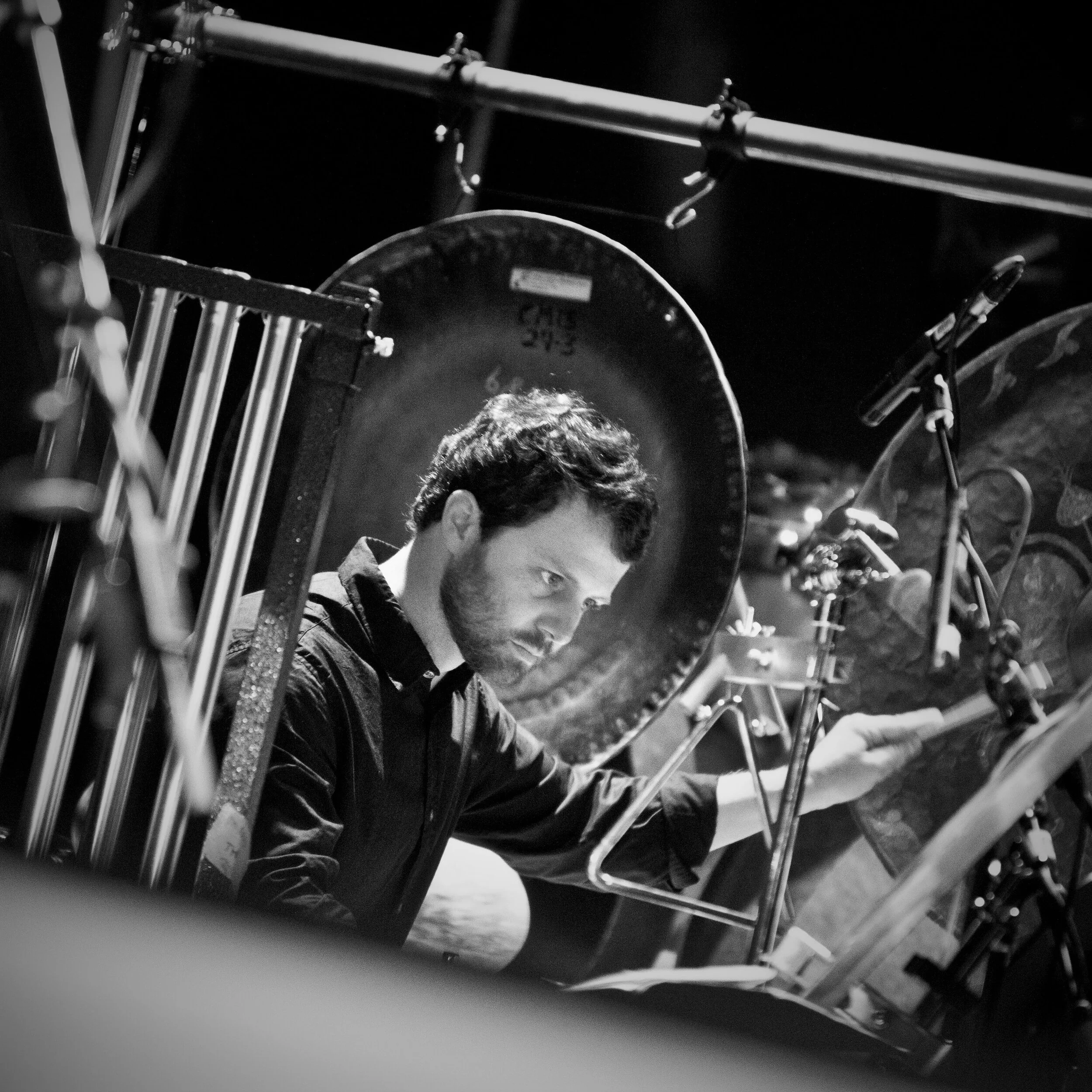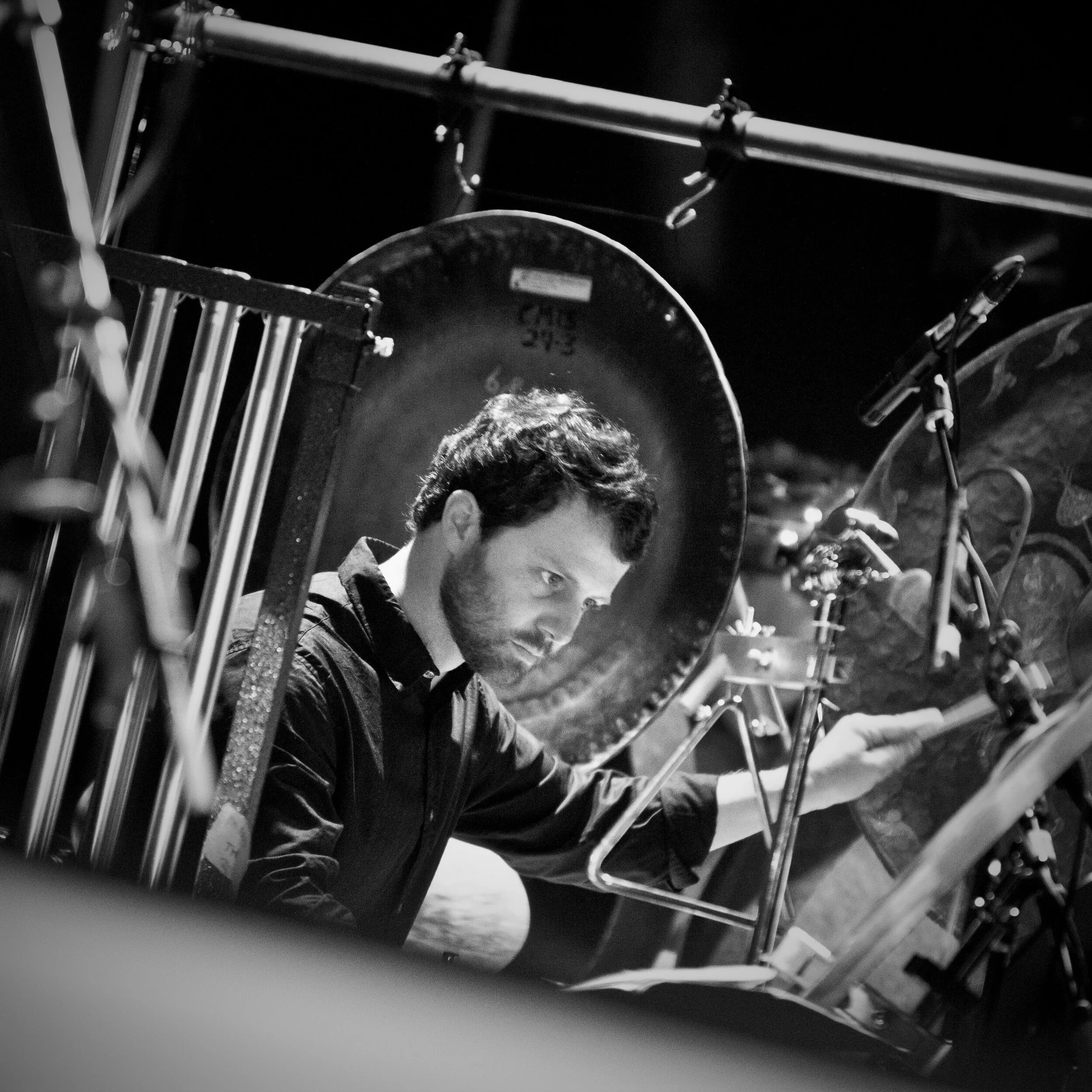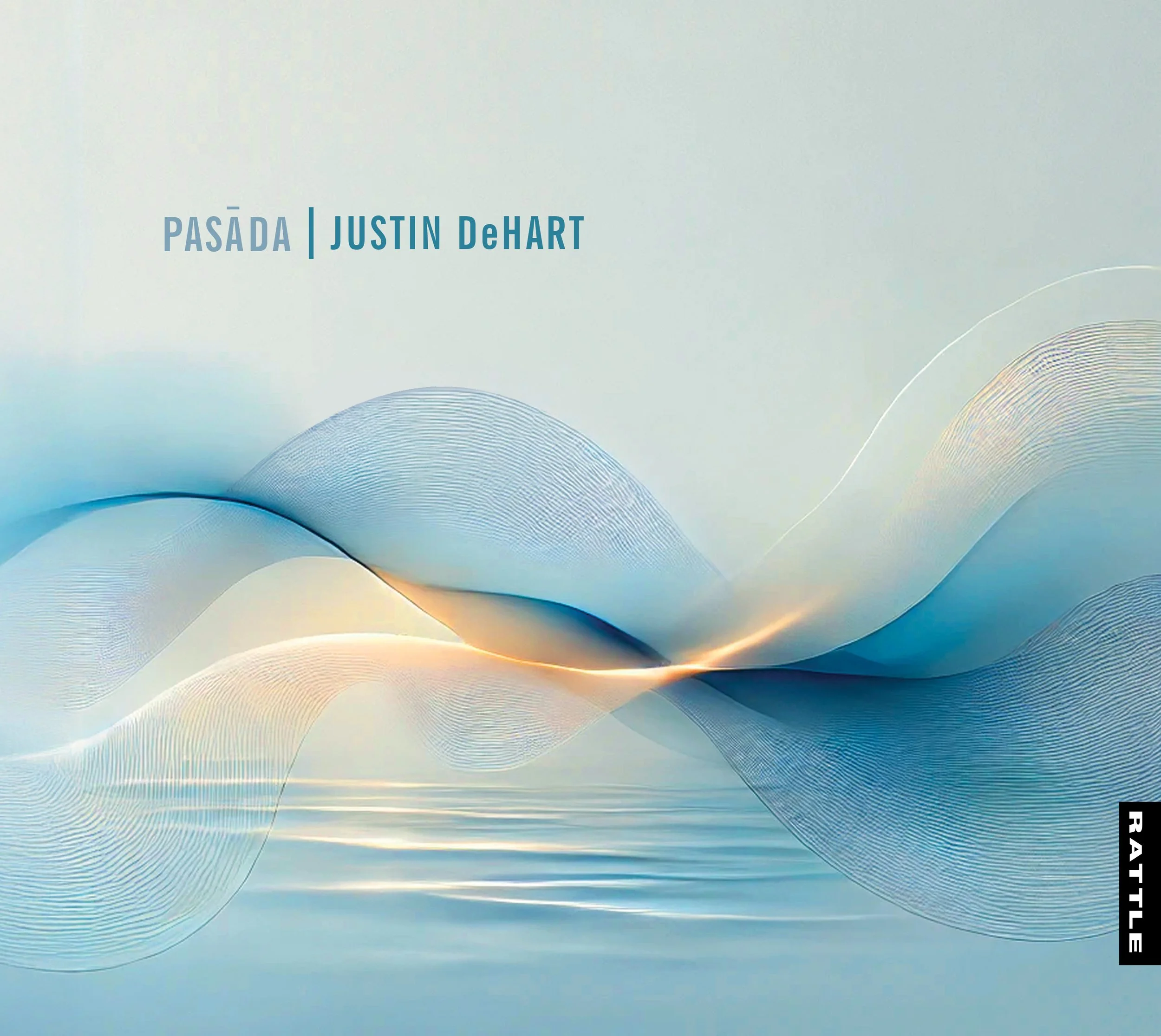Tautology (2021) for solo percussionist and three shadow percussionists
The title of this work refers in part to the tautness of the percussionists’ instruments – the tight resounding qualities of skins and surfaces under tension. Those tensions and the percussive actions and bounce reactions reflect life’s encounters and quotidian collisions ranging from the serious to the comedic, while the unrelenting and repetitive qualities of the music create a tense listening experience.
Tautologies are generally considered errors of expression – an overstatement or double expression of a single idea that brings nothing additional to its meaning. Musically, this work is very repetitive, the three shadow percussionists reiterating small chunks of the soloist’s statements as if ignorant of them having already been well expressed. The soloist’s shadow performers (be they real performers in the shadows, or recorded part-selves) may be considered through a Jungian lens as those dark, irrational and impulsive parts of ourselves we do not consciously acknowledge.
Glenda Keam
Bells/Mirrors
Composer, filmmaker, and mechatronics engineer David Downes sent me his marimba solo, Bells/Mirrors, after I met him and witnessed the premiere of his incredible robotic drum solo Superflux at the 2018 New Zealand Festival in Wellington. In 2019 I premiered the piece in Christchurch and set about to capture it as a recording for this project. The piece presents the performer with a considerable technical challenge to render the often non-idiomatic phrases and counterpoint. However, the numerous melodic gems, harmonic flow and increasing moments of silence make the journey well worth it.
Justin DeHart
Order 81
“War is a racket. It always has been. It is possibly the oldest, easily the most profitable, surely the most vicious. It is the only one international in scope. It is the only one in which the profits are reckoned in dollars and the losses in lives. A racket is best described, I believe, as something that is not what it seems to the majority of the people. Only a small 'inside' group knows what it is about. It is conducted for the benefit of the very few, at the expense of the very many. Out of war, a few people make huge fortunes.”
From ‘War is A Racket’ - Smedley Butler (United States Marine Corps Major General)
“Before it was known for its prison, the town of Abu Ghraib was known for its seed bank, started by local farmers in the 1970s. Before the 2003 U.S invasion, Iraqi scientists sent a black box containing the country’s seed stocks across the border to the International Center for Agricultural Research in the Dry Areas in Syria, a gene bank that holds samples of 131,000 discrete types of seeds for plants that support the diets of the nearly one billion people living in central and western Asia, the Middle East, and North Africa. Barley, beans, chickpeas, lentils - the seeds are catalogued and stored in sealed plastic bottles inside giant refrigerated vaults.
In 2004, Paul Bremer, the top civil administrator in charge of Iraq’s Coalition Provisional Authority, imposed more than one hundred laws on Iraq. Order 81 stipulated that genetically modified organisms could be introduced and plants could be patented, though Iraq’s constitution had previously prohibited the private ownership of biological resources. Farmers were no longer allowed to save or reuse their seeds. They had to destroy them each year and repurchase seeds from licensed authorized U.S. distributors. The ancestors of those who cultivated humans’ first crops were now forced, every year, to buy seeds and the pesticides those seeds require from American companies like Monsanto, Dow and Cargill. Penalties for not following Order 81 included fines or jail time.”
From ‘Draw Your Weapons’ - Sarah Sentilles
Not only is war abhorrent to me, but the fact that people exploit war for personal gain is atrocious. This piece is in response to war profiteering in general, and Order 81 specifically.
Musically, the material in this piece is constrained and repeating. There are two ideas in the piece. One represents the small place of humans in relation to the universe, and the other the daily life, man-made constraints, and objectionable things that humans do to each other to benefit themselves. There is an interplay between the two ideas that at times are contrasted and other times merged. This piece is intended to represent the repeating and inevitable nature of history. The intentionally ambiguous rhythms hover in a time structure which should feel expansive with an endless quality.
Alex van den Broek
Scales & Taonga
What will no doubt become a kind of composition sub-genre, Scales & Taonga is a ‘lockdown’ piece, largely composed in April 2020 when New Zealand went into (so far its only) national lockdown in response to the coronavirus.
Justin DeHart, my treasured colleague and friend at the University of Canterbury School of Music, had requested solo percussion music composed in/from Aotearoa/New Zealand for his repertoire, and in response, I offered a concept for a collection of pieces called Taniwhas/Dragons (for health) – Scales & Taonga being the first I wrote.
In this piece, the dragon/taniwha sits in a cave over its musical treasures; endlessly enthralled with the way the glittery sounds reflect its own, incandescent skin of scales. The musical treasures the taniwha has ‘stolen’ include catchy and attractive moments from J. S. Bach’s Jesus Christus, Heiland (number 16 from The 18 Chorale Preludes for organ); gorgeously clanking, distantly clattering fragments from a Webern string quartet; and Menzies’ tiny portrait piece Dragon for health, written for the people of Wuhan in February 2020, before most of us had realised how serious the upcoming pandemic was destined to be.
Mark Menzies
Plateaux
This piece is primarily concerned with cultivating and sustaining a high level of energy, often through very delicate modes of articulation on the four drums employed. It was composed for percussionist Samuel Solomon, whose collaboration has been invaluable to both conception and realisation.
Chris Gendall
Landfall – depicting an arrival (on land) of a sea or air journey.
Landfall maps a trajectory from celestial soundscape to earthy landing. Arvo Pärt’s technique of tintinnabulation provides the initial inspiration for the work. His contrast of the ‘pure’ triadic voice and straying stepwise movement represents the to and fro between humanity and the divine. This is extended to the gradually distorting sound world, in which timbre, pitch and rhythm depart from the lofty beginning to land within a muddied terrain.
Rosa Elliott
New Music Dance was born after a conversation with composer Robert Bryce where we discussed the various physical moves one has to make when interpreting new music on percussion. Unlike a pianist or trombone player, it might be a challenge to understand what a percussionist is doing if you were able to remove the mallets and instruments somehow and just analyse the body’s movement. While this piece doesn’t focus on the extremes of these (often ridiculous) movements, it plays with the angularity of gesture and extreme dynamics.
Justin DeHart
Silver Wind, Golden Earth, and White Water arose out of a collaboration between myself and London-based Polish choreographer Justyna Janiszewska. The collaboration began after I sent Janiszewska one of my pieces, Triptych for Two, and asked her to interpret it in any way she saw fit. Janiszewska responded by documenting her personal responses to the three movements of Triptych. For her, each movement suggested the pairing of a colour with an element. The first movement suggested the paring of silver and wind, the middle movement gold and earth, and the third movement evoked images of rushing white water. She then made a set of short dance films, with no music, and sent these back to me. I responded to those dance films in kind with these percussion miniatures, drawing the titles from Janiszewska’s notes and reflections. The percussionist is asked to find five elemental objects on which to perform: two made of metal, one of wood, and two ceramic objects. The music itself is free-flowing without a strict meter, creating a sonic impression of Janiszewska’s dance.
Simon Eastwood
Braided Plain Soundwalk utilises two stones, live electronic processing, quadraphonic sound spatialisation, and dynamic audio capture between two microphones. By cupping the hand and varying the striking location, the performer explores a variety of timbres on the stones while localising them into a particular microphone zone or somewhere within the “stereo” field. Each microphone is triggered separately by the two stones and sends information to the computer patch which then transforms the audio in various ways throughout the piece.
Justin DeHart



















